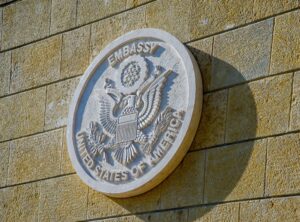Piotr A. Kowalski and Aleksander Konior from air quality data start-up Airly write about how their analysis suggests that air pollution is linked to faster spread of coronavirus.
Airly’s data indicates that even a small increase in particle pollution levels in the years before the pandemic is associated with an increase in the spread of coronavirus.
Cleaner air could have saved thousands of lives worldwide, as the research suggests that the number of people one sick person is likely to infect is higher in more polluted areas. Scientists are emphasising that dirty air was already known to increase the risk of acute respiratory distress syndrome, which is extremely deadly and a cause of Covid-19-related deaths, as well as other respiratory and heart problems.
PM2.5 dust is very dangerous for our health. It is perceived as especially damaging because it can accumulate deep in the lungs and penetrate into other organs and the bloodstream, causing a serious threat to health.
This is particularly relevant to coronavirus. Although the course and effects of the disease caused by the SARS-CoV-2 virus are still not fully understood, the infection causes symptoms similar to pneumonia.
In describing the course of SARS-CoV-2, the medical community draws much attention to the very important role of the existence of comorbidities, which significantly increase a patient’s risk profile.
These include many diseases of the circulatory and respiratory systems, to which breathing polluted air also contributes negatively.
Fig.1. Source: www.swissinfo.chThe very rapid expansion of the coronavirus is evident in Italy. A map of Italy showing the number of confirmed cases across provinces, reveals a large dark area in northern Italy around Rome and Naples. Comparing these areas with the data related to pollution (Fig.1), which can be found at www.airly.eu, and to that of national air quality monitoring agencies, we can clearly see two relationships.
The first is the absolute absence of problems with air pollution in Italy caused by PM10 dust.
On the other hand, if we look at PM2.5 dust condensation, very high correspondence can be seen in some areas. Namely, during the year, for every month from autumn to spring, many areas marked on the map enduring an intensive degree of SARS-CoV-2 infection (brown and dark brown) also endure profound levels of PM2.5 contamination.
It should be noted too, that this pollution event covers a very long time and intensity horizon. For example, in Lombardy, the sensors of the Milano Pascal Città Studi station recorded 10 days in September last year, 7 days in October, 5 days in November, December 18, in January 26 days and in February, 20 days in which air pollution showed increased AQI index indicating pollution above the norm.
What is more, in December, for 16 days, this index showed the highest alarm values (9-10). The situation is very similar if we consider the values of the AQI indexes in Napoli Museo Nazionale station in Naples. Here, from September 2019 to the end of February 2020, the index value for 84 days was greater than 4. In addition, in December 2019, this station indicated index above 7 for 14 days, and in January 2020 — an index value above 8 for 16 days. As a reminder, the AQI index assumes states from 0 to 10, where 0 means very good air and 9-10 very polluted.
Fig. 2. Source: https://en.wikipedia.org/wiki/2020_coronavirus_pandemic_in_ItalyA similar tendency persists in France (Fig. 3). Again, looking at the maps of intensification of SARS-CoV-2 virus infection, we see areas with a very large number of detected infections covering such regions of France as ÃŽle-de-France (with Paris), Grand Est, Hauts-de-France, Auvergne-Rhône-Alpes and Provence-Alpes-Cote d’Azur. Areas within the eastern part of the country also have a very large number of cases — and particularly of cases severe enough to require hospitalization.
Fig.3 Source: https://en.wikipedia.org/wiki/2020_coronavirus_pandemic_in_FranceComparing this area with places where there is a clear problem with air pollution in France, we again see very high convergence. In addition to large agglomeration clusters such as Paris, Lyon and Toulouse, intensive pollution is an aspect of life in the strip at the eastern border of the country, with the largest concentrations being encountered in areas near the Belgian and Swiss border in the vicinity of Lyon, as well as in the coastal strip from Nice to Montpellier.
Fig.4. Source: https://en.wikipedia.org/wiki/2020_coronavirus_pandemic_in_the_Czech_Republicc
In the Czech Republic (Fig. 4), despite the lack of effect of such a progressing pandemic as in Western Europe, the intensified pollution dominating in the capital, as well as in the eastern, highly industrialized parts of the country is very strongly correlated with the number of people who have been diagnosed with COVID-19 virus.
Fig.5. Source: Airly Inc.The example of Poland (Fig. 5, Fig. 6) is also quite interesting. Here, we have a lot of data related to air pollution thanks to the dense grid of Airly monitoring sensors. Figure 5 shows the average value of dust condensation PM10 and PM2.5 in the individual voivodeships of Poland. From the research conducted by the analytical group at Airly Inc., Poland is characterized by a large correlation of both components of pollution. The PM 2.5 dust map, however, indicates that in terms of dust concentration, the air quality of the northwest belt is much better than in the central parts.
Fig. 6. Source: https://www.arcgis.com/On comparing the areas of pollution from Airly maps with respect to Fig. 6, and correlating this with the total number of coronavirus infections within each individual voivodships, we again observe a very high convergence. Mazowieckie Voivodship is in the lead in the number of cases of Covid19, second place is occupied by the Upper Silesian Voivodship and the next by the Lower Silesian Voivodship. The MaÅ‚opolskie and Åódzkie voivodships are also quite close to the podium. From the pollution index maps, we can see that in all these areas, the average dust value oscillates from 19.58 to 29.84. The recommendations of the World Health Organization (WHO) regarding admissible daily concentrations was determined as 25 μg/m^3 for PM 2.5.
The relatively large number of cases of coronavirus infections found in the Mazowieckie Voivodeship (twice as many as in the second province in terms of the number of cases) does not correspond directly with the results of air pollution. In the authors’ opinion it’s caused by the significant globalization of Warsaw relative to the rest of Poland, which moves into a greater number of influxes from other countries, incoming all the time through land borders, and generally a much larger number of infections due to new outbreaks.
This behaviour is also very noticeable outside Europe. Moving overseas to the United States, it can be seen again that heavily urbanized areas with intensive PM2.5 dust pollution, such as New York City or Chicago, are enduring a galloping pandemic.
Looking to the other side of the world, i.e. to China, we see that heavy industrialization and its accompanying intensive air-pollution are distinctly correlated with SARS-CoV-2 infestation. The above is particularly noticeable in the province of Hubei and its capital Wuhan, where gigantic concentrations of PM2.5 dust are recorded during the year.
As part of this short review, it can be safely argued that regions of the world that have a significant problem with air pollution in the form of particulate matter, and in particular PM2.5, have very strong correlation to areas gravely affected by the virus crown pandemic. This pollution, acting systematically, has significantly deteriorated the properties of our respiratory and circulatory systems, and made us very susceptible to any respiratory illness. By polluting our environment with dusts such as PM2.5, we are also killing ourselves.
Wiktor Warchalowski, CEO & co-founder at Airly Inc said: ‘There’s a study from 2003 done by Chinese and US researchers showing that patients from areas with a high air pollution index were twice as likely to die from the SARS virus as those in areas where the index was low. Today our team is using our data and air quality models to determine if increased air pollution is linked to far higher Covid-19 spread. If air pollution is turning out to be a big contributor to coronavirus spread and/or death rates, the epidemic may end up making people more willing to do something about dirty air and climate change.’
You can see levels of air pollution from +4,000 cities thanks to MyAirly, a real-time platform that shows the air quality in your area and alerts you when levels are ‘bad’. By tracking all the key pollution markers – particulate matter (PM 1.0, PM2.5, PM10), NO2, O3, SO2 and CO gases – you can see a complete and accurate picture of the air you breathe.
Airly’s Data Science team is working also on the correlation between air pollution in the United States and Covid-19 death rates. We will be publishing more details soon.













Thank for this really very informative article. It will definitely gonna help us. How long this pollution event covers??
You are welcome!
Thanks for the prompt. It’s very insightful and we are sure to be supported. So how to reduce air pollution from earth??
The connection between air pollution and the coronavirus was inevitable. Every winter the problem with wood burning gets worse, the new Government measures are woefully inadequate. The pollution from woodsmoke MUST be stopped at source, by using filters in the chimney or flue. Other than this, burning wood should be BANNED altogether. What was the point of banning smoking when we are now suffering from something much worse? People heat their homes at times when most other people are at home, so thousands of innocent people are affected. It’s difficult now to even find fresh air in the countryside.